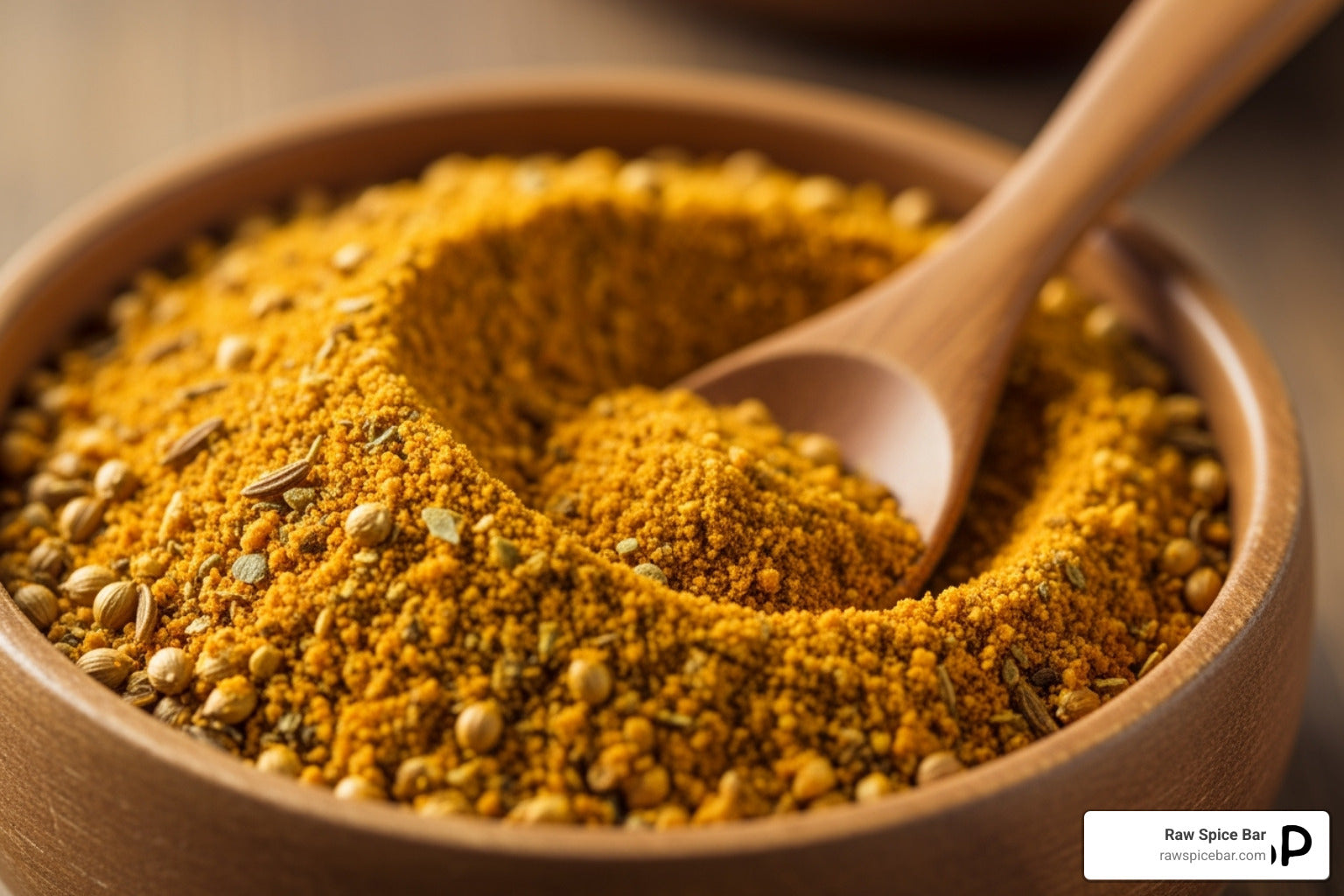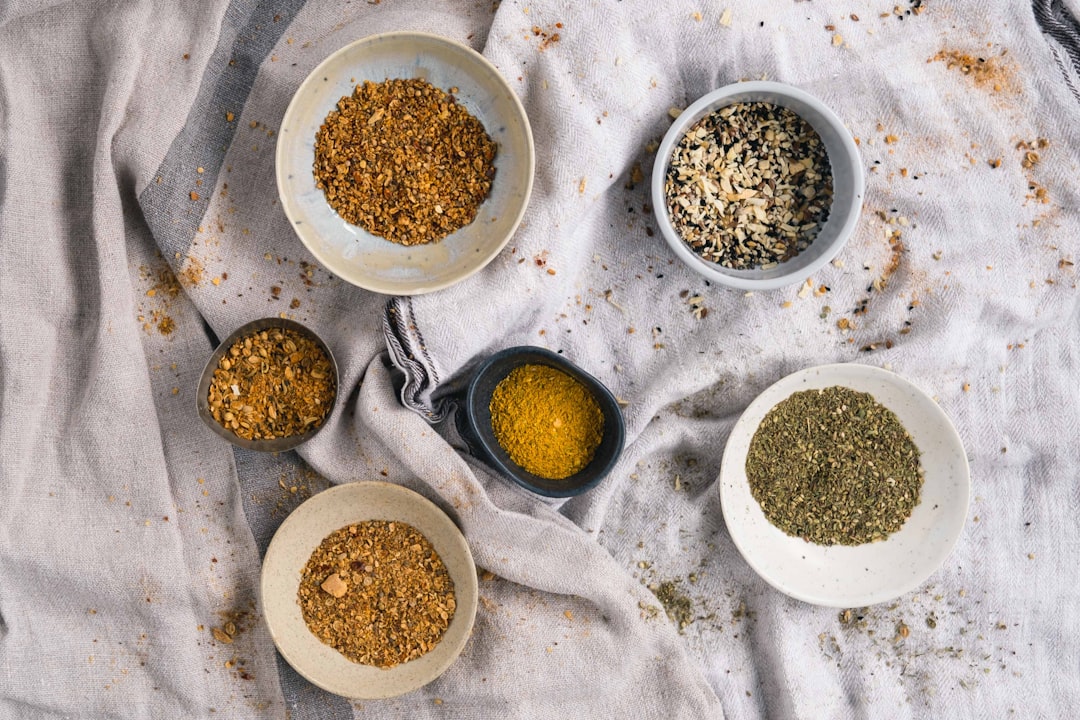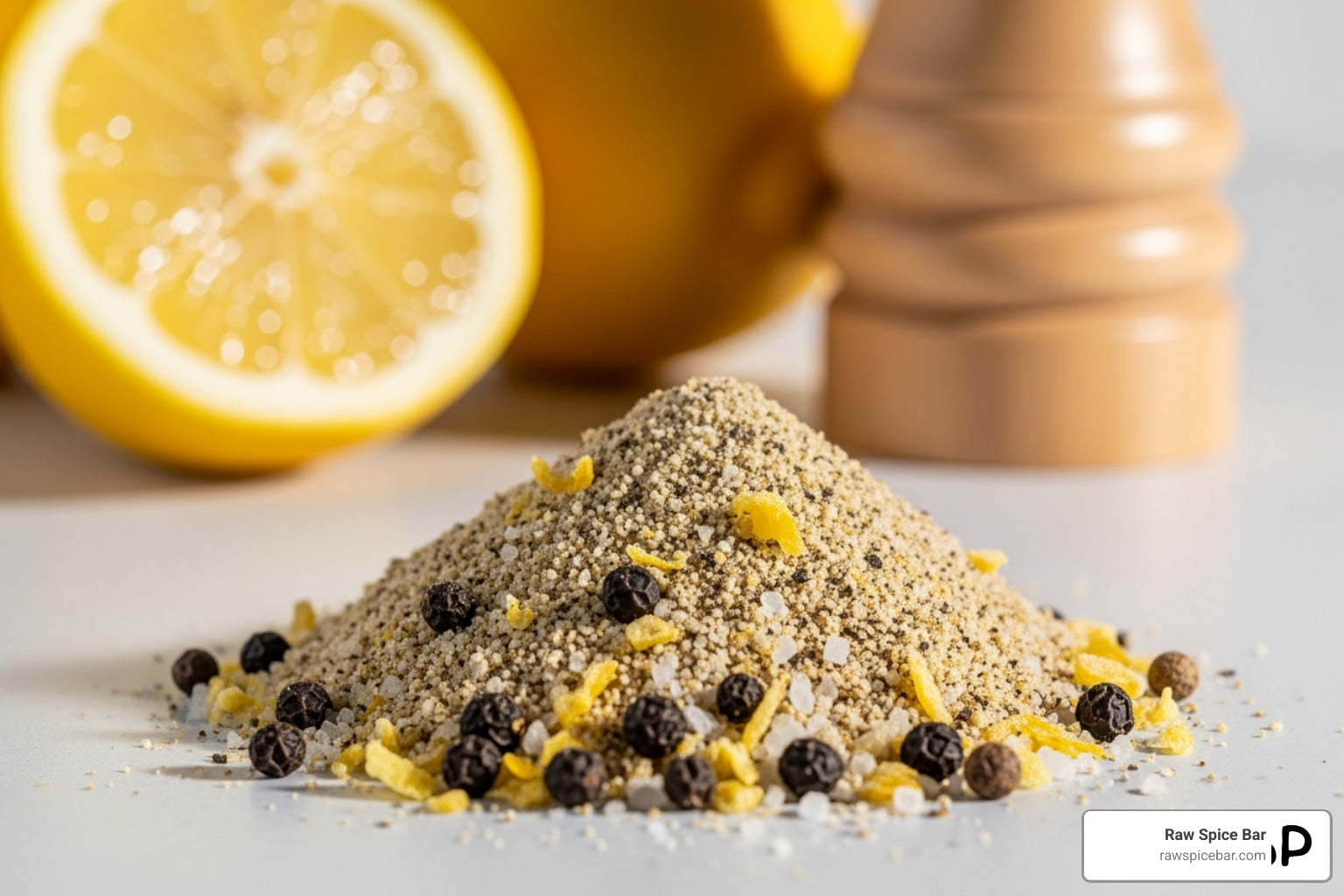Imagine infusing your meals with the finest artisanal spice blends, bringing the vibrant flavors of the world right to your kitchen.
Whether you're craving the smokiness of a BBQ, the zing of Mediterranean dishes, or the depth of exotic flavors from across the globe, these expertly crafted blends will transform your everyday dishes into something extraordinary.
At Raw Spice Bar, we believe that cooking should be an adventure—a journey of authenticity and creativity. Our global spice subscription delivers fresh, salt-free blends to your door, allowing you to experiment with new flavors and create dishes that sing with depth and character. Each month, discover exciting spice blends and receive recipe cards that guide you in making meals you'll love.
Ready to add some spice to your cooking?
Imagine each meal becoming an international journey, full of vibrant colors and bold aromas. Say goodbye to bland, store-bought spices and embrace the quality and richness of our handcrafted blends.
With Raw Spice Bar, elevate your cooking and explore a world of flavor—all without leaving your kitchen!
In this blog, we will cover:
-
The history and art of spice blending across different cultures
-
How artisanal spice blends can elevate everyday dishes
-
Tips on selecting, storing, and experimenting with spice blends
Let’s dive in!
The Art of Spice Blending
Spice blending is an age-old practice that transforms meals into culinary experiences. It delves into history and culture, creating unique flavors that transport you to different places.
Historical Significance
Spices have been used for thousands of years for flavor, currency, and medicine.
Ancient trade routes like the Silk Road facilitated the exchange of spices such as cinnamon, cardamom, and pepper, which were highly prized for their rarity and exotic flavors. This historical movement of spices spurred cultural exchanges and culinary developments worldwide.
Many traditional blends we cherish today, like garam masala or za’atar, are rooted in these rich histories, bringing ancient flavors into modern kitchens.
Spice Blends Across Cultures
Different cultures have developed unique spice blends that reflect their geographical and cultural influences.
In India, garam masala brings warmth and complexity to dishes. Meanwhile, Ethiopian cuisine is known for its Berbere blend, combining heat with aromatic spices. You receive fresh, healthy blends that make cooking easy and enjoyable. Recipe cards included allow you to experiment with global flavors in your kitchen.
By embracing these cultural blends, you enhance your cooking and connect with a tapestry of traditions from around the world.
Selecting Quality Ingredients
Choosing quality ingredients is key to creating spice blends that elevate dishes. The freshness of spices and their sources significantly impact flavor. To produce exceptional meals, focus on sourcing spices responsibly and ensuring they are fresh and potent.
Sourcing Spices
Finding high-quality spices begins with understanding their origins.
Locally sourced spices often provide the freshest taste. However, you might need to look globally for unique and diverse flavors. Be sure to look for companies that practice ethical sourcing and fair compensation.
This supports local farmers and ensures you receive spices harvested at their highest quality.
Understanding Freshness and Potency
The potency of spices can fade over time, so it's crucial to know how fresh they are.
Fresh spices have vibrant colors and strong aromas. Check for a packaging date when purchasing. We ensure freshness by delivering its spice blends within 60 days of blending. To maintain maximum potency, store spices in a cool, dark place and keep them in airtight containers.
Rotate your spice collection regularly and replace any that have lost their aroma or flavor. This dedication to freshness guarantees your dishes are packed with deep, mouth-watering flavors.
Creating Artisanal Spice Blends
Creating artisanal spice blends at home allows you to tailor flavors to your liking. You can elevate any dish with unique, rich aromas and tastes by balancing spices correctly, using proper grinding techniques, and thoughtfully combining different spices.
Balancing Flavors
A great spice blend starts with balancing flavors.
Consider the main types of tastes: sweet, salty, sour, bitter, and umami. For example, if you use cinnamon or nutmeg for sweetness, balance it with savory spices like cumin or coriander.
Each spice contributes a distinct note. For a warm blend like garam masala, mix ground spices, including cardamom, cinnamon, and cloves. Experiment with proportions to complement each other.
Simple Tip: Start with small quantities; you can always adjust later. Too much of one spice can overpower the others, so a measured approach helps maintain harmony in your blend.
Grinding Techniques
Grinding your spices enhances flavor by releasing essential oils.
Use a mortar, pestle, or spice grinder to obtain the right texture. Freshly ground spices are more aromatic than pre-ground versions from the store, delivering depth and character to your dishes.
Ensure spices are dry before grinding to prevent clumping. Grind in batches to manage uniformity and avoid overloading your grinder.
Pro Tip: Sift the ground spices to remove large pieces for a smooth texture. This technique ensures your blend is consistent throughout.
Combining Spices
When combining spices, consider their role in the dish.
For curries, mix complementary spices that work well together, like coriander, cumin, and turmeric. Artisanal blends can inspire your creations.
Consider the cooking method, too. Slow-cooked dishes can develop complex flavors with longer spice infusions, while quick-fry meals benefit from sharp, intense spice notes.
Keep a journal of your mixes and tweak them as necessary. This will help you track what works best for specific dishes and refine each blend over time.
Application in Cooking
Using artisanal spice blends can transform ordinary dishes into culinary masterpieces. These blends, crafted for specific recipes, offer unique flavors for meat, poultry, seafood, vegetarian dishes, soups, and stews.
Meat and Poultry
Enhancing meat and poultry dishes with artisanal spice blends can take your meals to the next level.
Blends like the Creole or Greek mixes add depth to meats with their rich ingredients, delivering flavors from around the world straight to your plate. Use these blends as rubs before grilling or roasting.
You can also try incorporating spices into marinades for added flavor. A well-seasoned chicken breast or steak can excite the senses with captivating aromas and tastes. Pair every bite with side dishes that complement the seasoning to make meals unforgettable.
Seafood
When seasoning seafood, it's important to highlight its natural flavors without overwhelming them. Spice blends with citrus and herbs work best for fish and shellfish. A subtle touch of lemon zest or dill can beautifully enhance the taste of salmon or shrimp.
For those who enjoy more intense flavors, try a blend with garlic and paprika for grilled fish. These spices bring warmth and earthiness, complementing the day's fresh catch. You can even finish your dish with a touch of heat from chili flakes to invigorate the palate, making every seafood dish an adventure in taste.
Vegetarian Dishes
Spice blends enrich vegetarian dishes, offering diverse flavors that elevate simple vegetables and grains.
Blends incorporating cumin, coriander, and turmeric can transform vegetables into vibrant dishes reminiscent of Middle Eastern cuisine. Stir fry spices with ginger and soy notes can infuse tofu and vegetables with depth.
Incorporate these spices during cooking or sprinkle them on top as a garnish for an added flavor.
Soups and Stews
Soups and stews benefit immensely from a curated mix of spices.
Blends featuring bay leaves, allspice, and black pepper can intensify the flavors and aromas that develop as these dishes simmer. These spices meld with the broth, absorbing and enhancing flavors throughout.
Adding a pinch of cinnamon or nutmeg brings warmth and a hint of sweetness, perfect for hearty winter stews. To capture global influences, experiment with exotic blends that showcase flavors from different cuisines. You can transform a simple soup or stew into a comforting, complex dish with the right spices.
Storage and Shelf Life
Understanding how to store your spices can significantly affect their flavor and longevity. Proper storage not only retains the fresh taste but also helps ensure that each dish you create bursts with vibrant flavors.
Optimal Storage Conditions
For spices to maintain their best flavor, keeping them in the right conditions is crucial.
Ground spices have a shorter shelf life than whole spices, so pay special attention to storing them correctly—store spices in airtight containers to limit their exposure to air, which can cause loss of flavor.
Place these containers in a cool, dark spot away from heat and moisture. Heat and light can quickly deteriorate the quality of spices.
Avoid storing spices above the stove or near windows to reduce their chance of losing taste.
Maximizing Freshness
To make the most of your spices, consider buying in small quantities. This way, you ensure that each batch is used while still fresh.
Use freshly ground spices for the most robust flavor within 4 to 8 months, as they lose their potency faster than whole spices. Thanks to their lower surface area, whole spices can last longer, often staying fresh for up to four years if stored correctly. If you notice any aroma or dull color loss, it's likely time to replace them.
By sticking to these guidelines, you'll ensure every meal has rich flavors that excite cooking.
Tips and Tricks
Enhancing your dishes with spice blends can transform everyday meals into flavorful experiences. Artisanal blends provide unique tastes, especially when catering to dietary needs or adding quick bursts of flavor. Here are practical tips to get the most from these blends.
Blending for Dietary Restrictions
When dealing with dietary restrictions, choosing the right spice blend is crucial. Look for spice mixtures free from allergens like gluten, nuts, and dairy. At Raw Spice Bar, many blends are crafted to be salt-free and free from common allergens.
Consider mixes like Herbs de Provence for a versatile, allergy-friendly option. This blend complements many dishes without relying on salt or unhealthy additives. Explore global spices that align with vegan or gluten-free diets, using them to add hearty flavors without compromising nutritional needs.
This approach ensures everyone can enjoy flavorful meals safely.
Quick Flavor Boosts
Sometimes, you need a fast way to elevate a dish.
Spice blends are excellent for this quick boost. Our spice subscription offers new blends with recipe cards to inspire quick enhancements in your cooking routine.
Sprinkle blends like Cajun or Harissa over roasted vegetables or grilled meats for a speedy upgrade. These mixes provide depth of flavor without requiring long preparation. For salads, consider a dash of Za'atar or Sumac for a tangy twist that takes mere seconds to apply.
This method keeps meals interesting and full of vibrant tastes, reinforcing the idea that even simple dishes can become extraordinary.
Pairing Spices with Dishes
Spices can elevate the flavor of any dish when used correctly. Understanding how different spices work together and experimenting with unique combinations can transform your home-cooked meals into gourmet experiences.
Here’s how you can do just that.
Complementary Flavor Profiles
When pairing spices, focus on how flavors interact.
Spices like cinnamon provide sweet warmth, while cumin offers earthy notes. Pair these with dishes that can handle strong flavors, like a spicy curry or savory stew.
Garlic and rosemary complement meats, enhancing each bite. A hint of smoked paprika can add depth to Spanish dishes, while basil can lighten up Italian recipes. Choose spices that complement, not overpower.
Experimenting with New Combinations
Trying new spice combinations can be exciting and rewarding.
Start by picking spices you're curious about. Nutmeg and cardamom might surprise you in a creamy dessert, just as ginger can transform a simple stir-fry into something extraordinary.
Experimentation is key. Start with small amounts, adjusting to taste. Keep a journal of what works well together to replicate successful flavors.
At Raw Spice Bar, fresh spice blends are designed to inspire creativity in the kitchen. Each month, you receive new blends with unique recipes, encouraging you to try dishes you might never have considered.
This approach boosts your cooking skills and makes every meal an adventure.
Frequently Asked Questions
Are you curious about how to take your spice game to the next level? Whether you’re looking to create your own spice blends or discover ways to enhance your cooking with ready-made ones, we’ve got you covered. Here are some of the most common questions we get about using, creating, and storing spices to help you get the most flavor out of every dish.
How can homemade spice blends improve my cooking?
Using homemade spice blends lets you control the flavor, quality, and freshness of your meals. Blending your own spices can elevate dishes and make them uniquely yours.
What are the key ingredients for a complete seasoning recipe?
A good seasoning blend includes salty, sweet, spicy, and savory elements. Garlic, onion, paprika, and herbs like thyme and oregano are common ingredients. Fresh ingredients ensure the best flavor.
What techniques can I use to enhance the flavors of my spices?
To enhance spice flavors, consider toasting whole spices before grinding them. This brings out their natural oils and makes a more aromatic mix. Adding a touch of citrus zest or freshly ground pepper can add depth, too.
What are the top spice mixes that chefs recommend for versatile use?
Popular blends include Garam Masala, Herbes de Provence, and Berbere. These mixes add bold flavors and are versatile across different cuisines. Experimenting with these can transform your at-home cooking.
How can I create my own seasoning powders and spice mixes at home?
Start by selecting fresh, whole spices. Use a mortar and pestle or spice grinder to make a fine powder. Mix spices in small batches to maintain freshness. If you're seeking inspiration, the Raw Spice Bar subscription provides exclusive blends and ideas monthly.
What advice do experts give for storing homemade spice blends for maximum freshness?
Store spice blends in airtight containers in a cool, dark place. This prevents loss of flavor and aroma—label with dates to track freshness and replace after a year to ensure optimal taste.




